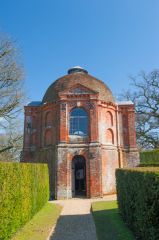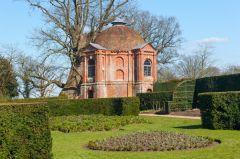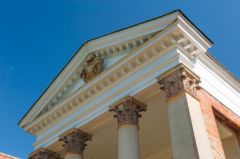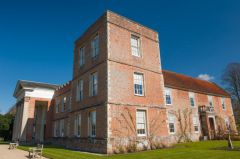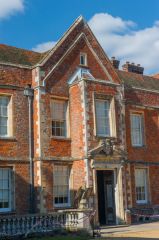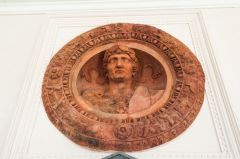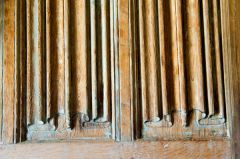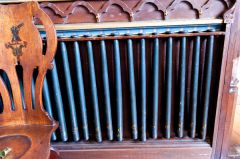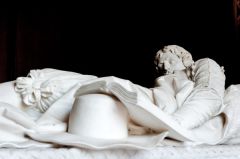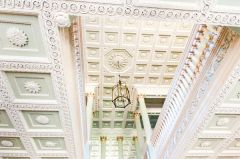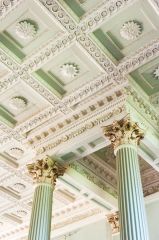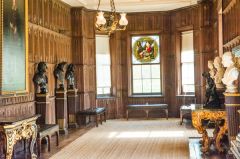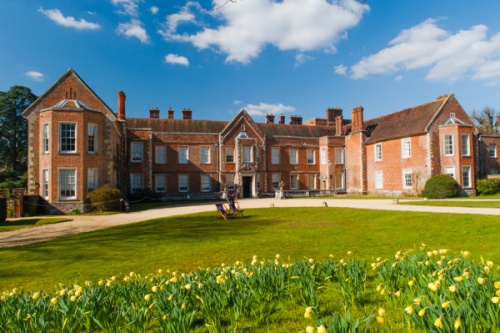
About The Vyne
The Vyne is a beautiful Tudor house built in 1500-1520 for William, Lord Sandys, Lord Chamberlain to Henry VIII. The house later passed to the Chute family, who still own it today, though it is now cared for by the National Trust.
Among the highlights are a superb Tudor chapel and an ornately decorated Palladian staircase, as well as the striking neo-classical portico that is one of the earliest in England. In fact, as you explore The Vyne, you will find the phrase 'one of the earliest ...' pops up with frequency.
The summerhouse's neo-classical dome is among the earliest in England, as is the huge portico, and the Oak Gallery is one of the earliest examples of a long gallery in the country. Perhaps that helps to emphasise just how important a house The Vyne was and how rich and influential the Sandys family were. Henry VIII came here on three occasions, and his daughter Elizabeth I visited once.
The striking north portico was designed by John Webb, who studied under Inigo Jones. The portico was built around 1654 and looks out over a sloping lawn that runs down to the edge of a narrow lake.
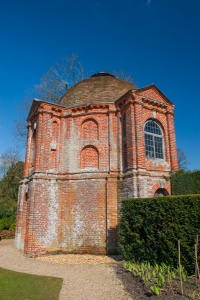
The Sandys and Chutes
William Sandys was one of the most important figures at the court of Henry VIII. He rose to become Henry's Lord Chancellor, and hosted the king on several occasions at The Vyne. The Sandys lived here until the mid-17th century, but their fortunes suffered during the Civil War and in 1653 they sold the estate to Chaloner Chute, a wealthy barrister.
Chute later entered politics as an MP and rose to become Speaker of the House of Commons. One of the first things the Chutes did was to pull down over half of the house, transforming the Vyne from a huge palatial residence into a much more friendly family home.
Subsequent Chute owners redecorated parts of the interior so that today as you pass through the house you move from one century to another with bewildering frequency!
The Chutes owned The Vyne for the next 3 centuries before it passed to the National Trust (technically the Chute family still own the house, but it is managed by the Trust). One of the most intriguing of the Chutes was John Chaloner Chute, a friend of Horace Walpole.
Walpole visited The Vyne regularly, and the chambers he used are just off the entrance hall. One of these is the Strawberry Parlour, named for Walpole's extraordinary Gothick House at Strawberry Hill, Twickenham.
Walpole and Chute used to discuss their ideas for decorating Strawberry Hill, and Walpole encouraged Chute to follow his lead and turn The Vyne into a Gothick palace. Chute - probably wisely - decided that the expense would be prohibitive. He did, however, design the extraordinary Palladian Staircase Hall that is one of the most striking features of The Vyne.
This exquisitely ornate staircase is a symphony of Georgian neo-classical elegance, with gilded cornices and delicately coffered ceiling and classical columns in both Doric and Corinthian orders. You will be forgiven if your reaction on seeing the staircase for the first time is to stop dead in your tracks!
The Staircase Hall is - to my eyes at least - one of the highlights of 18th-century design in any English country house. As far as we know John Chute himself was responsible for the entire design, including the beautifully balanced soft blue and white colour scheme.
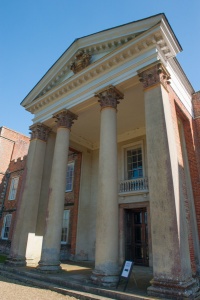
The House
The first chamber you see on entering the house is the Stone Gallery, a long chamber packed with pieces of classical stonework and statues collected by John Chute on his Grand Tour of the European continent in the mid-18th century.
Directly opposite the entrance is a striking terracotta bust of Emperor Probus. This was thought to date to the 3rd century but we were informed by the National Trust guide that it was actually a later reproduction in classical Roman style.
Other chambers on the ground floor include the Further Drawing Room, with a lovely plaster ceiling and brocatelle wall hangings in silk and linen, and the Dining Room, with wonderful Tudor panelling.
There is a small collection of ceramics including a set of Italian lattimo ware, purchased by John Chute on his Grand Tour. These white-glass plates, painted with scenes of Venice, were popular in the 18th century as a cheaper option to expensive porcelain.
One of the subsequent chambers has a wonderful collection of 'Corn Law truncheons' against one wall. These thick black clubs, looking for all the world like small baseball bats, were crafted in the early 19th century after the passage of the Corn Laws led to a steep rise in food prices.
Poor labourers rioted and a mob of 300-400 people marched on The Vyne. They were stopped by armed soldiers at Baughurst and never reached the house, but the Chutes must have been nervous! Twenty of the rioters were arrested and 2 were hanged, the rest transported. The truncheons were distributed to special constables at East Sherborne during the troubles.
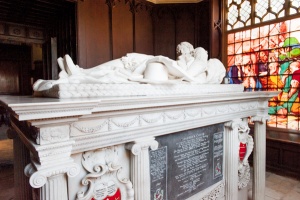
The Tudor Chapel
One of the historic highlights of The Vyne is the early 16th century chapel, one of the finest Tudor chapels in the country, built from 1518-1527. Henry VIII is known to have worshipped here, on his periodic visits to The Vyne. The chapel floor is set with beautiful 16th-century Flemish Majolica tiles illuminated by light from tall 16th century stained glass windows, and the sides of the chapel are lined with original choir stalls, the wood darkened with age.
If you can lift your eyes from the tiles to the gallery overlooking the chapel you will see a wonderfully painted set of trompe l'oeil painted panels, made to resemble the fan-vaulted splendour of Gloucester Cathedral, a theme supposedly suggested by Horace Walpole.
These murals were created in 1769 by the Italian artist Spiridione Roma - all except one, which is a modern replica for a panel that was lost - can you guess which one? In a small room off the main chapel is a Tomb Chamber built by John Chute around 1770 in honour of Chaloner Chute. This Tomb Chamber is almost completely filled with the ornate table tomb and effigy of Chaloner Chute.
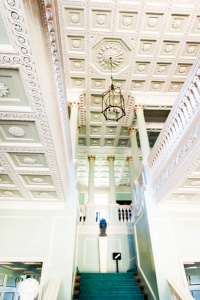
Apart from the chapel perhaps the most intriguing room inside The Vyne is the Oak Gallery, one of the earliest examples of a long gallery in England and a rare survivor from the first half of the 16th century.
This long, slender room was designed to provide a space to exercise indoors during inclement weather, but also to provide a place for showing off artwork and fine furniture. The Gallery is lined with beautifully carved wooden linenfold panelling, embellished with heraldic symbols that include both the Sandys family and their powerful allies and patrons. Look for the Tudor rose of Henry VIII and the pomegranate of his first wife, Catherine of Aragon.
Willliam Sandys may have had a few awkward moments when Henry later visited The Vyne with his second wife, Anne Boleyn! The gallery is remarkably untouched by later changes in fashion, and the woodwork here is quite magnificent. Also on the first floor is a tapestry room, filled with Soho tapestries made around 1720.
The Jane Austen Connection
From 1791-1819 James Austen was the vicar of Sherborne St John village. His sister was novelist Jane Austen, who visited on several occasions. Jane and her sister Cassandra are known to have attended dances at The Vyne. While he was growing up at Sherborne St John James's son, James Edward (known as Edward within the family) met Emma Smith, the niece of the Chute owners of The Vyne, and in 1828 they married.
Garden Highlights
The house looks out across a small lake, part of 13 acres of gardens, woodlands, and meadows at The Vyne. The trail from the entrance to the grounds leads past a small lake with a lovely little waterfall to a small formal garden.
The centrepiece of this garden area is a red-brick summerhouse, built in the mid-16th century and featuring one of the earliest neo-classical domes in the country. It was used as an elegant, sheltered place to take tea, but later put to more practical use as a dovecot. Across clipped hedges from the formal garden is a sizeable walled kitchen garden (and a play area for children).
Simon Jenkins, in his popular book England's Thousand Best Houses, calls The Vyne 'the loveliest mansion in Hampshire'. I'd say that's a fair assessment!
HISTORICAL HIGHLIGHTS
- Neo-classical portico by John Webb
- 16th-century domed summerhouse
- Tudor chapel
- Palladian Staircase Hall
- Tudor Oak Gallery
About The Vyne
Address: Vyne Road,
Sherborne St John,
Basingstoke,
Hampshire,
England, RG24 9HL
Attraction Type: Historic House
Location: 4 miles north of Basingstoke, off the A340
Website: The Vyne
Email: thevyne@nationaltrust.org.uk
National Trust - see also:
National Trust memberships (official website link)
Location
map
OS: SU639 576
Photo Credit: David Ross and Britain Express
HERITAGE
 We've 'tagged' this attraction information to help you find related historic attractions and learn more about major time periods mentioned.
We've 'tagged' this attraction information to help you find related historic attractions and learn more about major time periods mentioned.
Historic Time Periods:
Find other attractions tagged with:
16th century (Time Period) - 17th century (Time Period) - 18th century (Time Period) - 19th century (Time Period) - 3rd century (Time Period) - Anne Boleyn (Person) - Civil War (Architecture) - Decorated (Architecture) - Elizabeth I (Person) - Georgian (Time Period) - Henry VIII (Person) - Inigo Jones (Person) - neo-classical (Architecture) - Palladian (Architecture) - Roman (Time Period) - Tudor (Time Period) -
NEARBY HISTORIC ATTRACTIONS
Heritage Rated from 1- 5 (low to exceptional) on historic interest
Silchester Roman City - 3 miles (Roman Site) ![]()
Silchester, St Mary's Church - 3 miles (Historic Church) ![]()
Basing House - 3.4 miles (Historic House) ![]()
Stratfield Saye, St Mary's Church - 4.2 miles (Historic Church) ![]()
Stratfield Saye - 4.5 miles (Historic House) ![]()
Odiham Castle - 6.4 miles (Castle) ![]()
West Green House Garden - 6.7 miles (Garden) ![]()
Hartley Wintney, St Mary's Church - 8 miles (Historic Church) ![]()
Nearest Holiday Cottages to The Vyne:
Hartley Wintney, Hampshire
Sleeps: 5
Stay from: £655 - 2535
Hartley Wintney, Hampshire
Sleeps: 6
Stay from: £960 - 3331
More self catering near The Vyne
